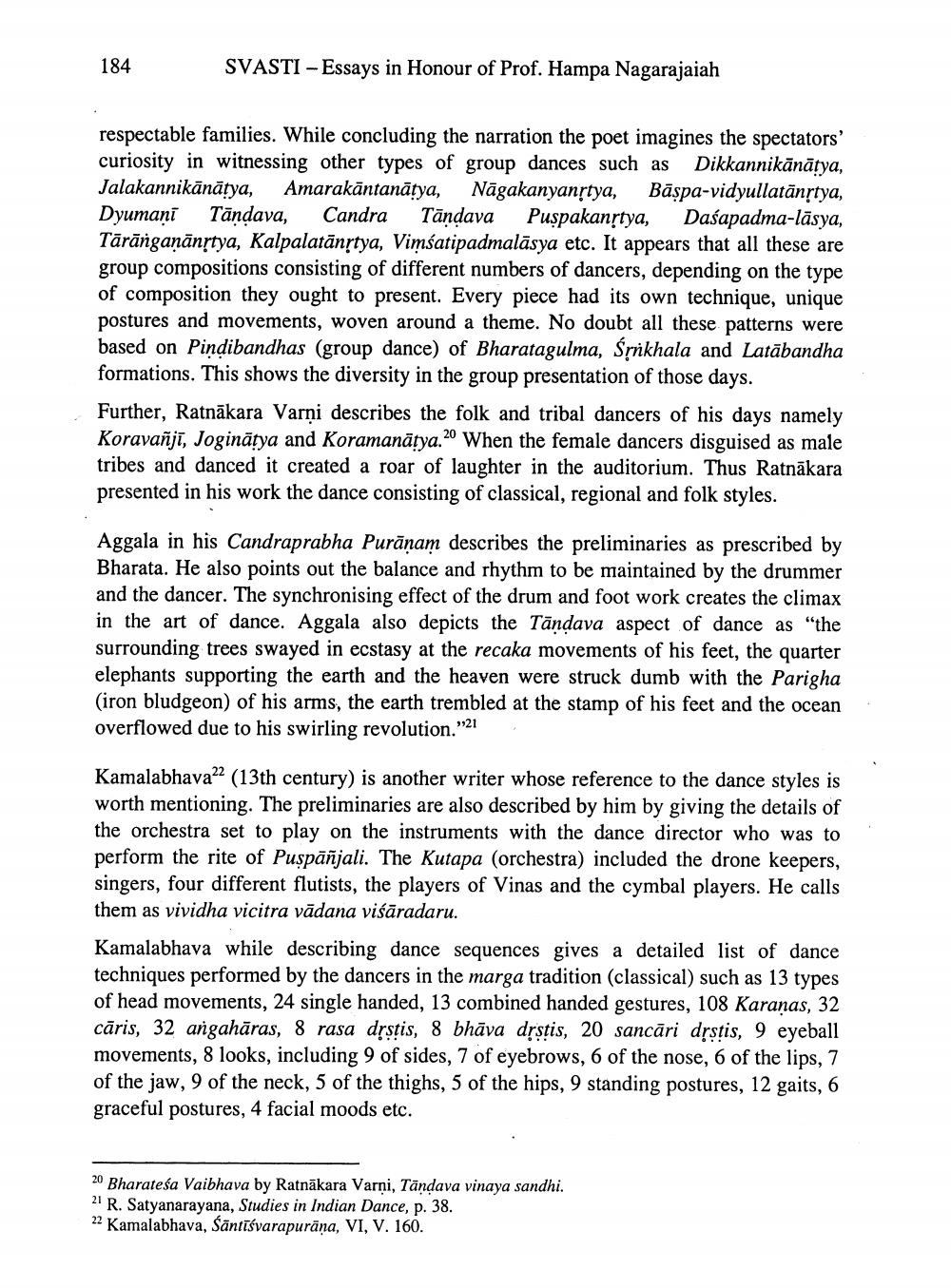________________
184
SVASTI - Essays in Honour of Prof. Hampa Nagarajaiah
respectable families. While concluding the narration the poet imagines the spectators' curiosity in witnessing other types of group dances such as Dikkannikānātya, Jalakannikānātya, Amarakāntanātya, Nāgakanyanstya, Bāşpa-vidyullatānstya, Dyumani Tāndava, Candra Tāndava Puspakanţtya, Daśapadma-lāsya, Tārānganānrtya, Kalpalatānrtya, Vimsatipadmalāsya etc. It appears that all these are group compositions consisting of different numbers of dancers, depending on the type of composition they ought to present. Every piece had its own technique, unique postures and movements, woven around a theme. No doubt all these patterns were based on Pindibandhas (group dance) of Bharatagulma, Śrrkhala and Latābandha formations. This shows the diversity in the group presentation of those days. Further, Ratnākara Varni describes the folk and tribal dancers of his days namely Koravañjī, Joginātya and Koramanātya.20 When the female dancers disguised as male tribes and danced it created a roar of laughter in the auditorium. Thus Ratnākara presented in his work the dance consisting of classical, regional and folk styles.
Aggala in his Candraprabha Purānam describes the preliminaries as prescribed by Bharata. He also points out the balance and rhythm to be maintained by the drummer and the dancer. The synchronising effect of the drum and foot work creates the climax in the art of dance. Aggala also depicts the Tāndava aspect of dance as "the surrounding trees swayed in ecstasy at the recaka movements of his feet, the quarter elephants supporting the earth and the heaven were struck dumb with the Parigha (iron bludgeon) of his arms, the earth trembled at the stamp of his feet and the ocean overflowed due to his swirling revolution."21
Kamalabhava?? (13th century) is another writer whose reference to the dance styles is worth mentioning. The preliminaries are also described by him by giving the details of the orchestra set to play on the instruments with the dance director who was to perform the rite of Puspāñjali. The Kutapa (orchestra) included the drone keepers, singers, four different flutists, the players of Vinas and the cymbal players. He calls them as vividha vicitra vādana viśāradaru. Kamalabhava while describing dance sequences gives a detailed list of dance techniques performed by the dancers in the marga tradition (classical) such as 13 types of head movements, 24 single handed, 13 combined handed gestures, 108 Karanas, 32 cāris, 32 angahāras, 8 rasa drstis, 8 bhāva drstis, 20 sancāri drstis, 9 eyeball movements, 8 looks, including 9 of sides, 7 of eyebrows, 6 of the nose, 6 of the lips, 7 of the jaw, 9 of the neck, 5 of the thighs, 5 of the hips, 9 standing postures, 12 gaits, 6 graceful postures, 4 facial moods etc.
20 Bharateśa Vaibhava by Ratnākara Varņi, Tändava vinaya sandhi. 21 R. Satyanarayana, Studies in Indian Dance, p. 38. 22 Kamalabhava, Sāntīśvarapuräna, VI, V. 160.




